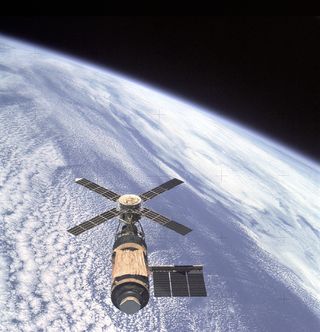
Apollo 11's 50th isn't the only big human-spaceflight anniversary this month.
Forty years ago today (July 11), NASA's defunct Skylab space station came crashing back to Earth, dropping big hunks of hardware into the Indian Ocean and across Western Australia.
The fall marked the official end for America's first crewed orbital outpost — and famously prompted the Aussie town of Esperance to charge NASA $400 for littering.
Related: Skylab: The First U.S. Space Station (Photos)
Skylab leveraged Apollo hardware that was left over after the final three missions of the moon program were canceled in the early 1970s. (NASA also used some of this gear for the Apollo-Soyuz Test Project, a historic 1975 joint space mission with the Soviet Union.)
Skylab itself was a modified third stage of a Saturn V moon rocket, and it launched atop a Saturn V on May 14, 1973 — the final mission for the storied booster. Astronauts traveled to and from Skylab in the Apollo command and service module, which was lofted by the Saturn 1B, the Saturn V's smaller cousin.
NASA's Skylab plans called for three crewed missions, each lofting three astronauts.
Get the Space.com Newsletter
Breaking space news, the latest updates on rocket launches, skywatching events and more!
The first crew launched just 11 days after Skylab itself did, taking flight on May 25, 1973. The three astronauts — Charles Conrad, Paul Weitz and Joseph Kerwin — stayed aloft for 28 days, setting a record for the longest continuous in-space stint. (The old record, 23 days, had been set in 1971 by cosmonauts aboard the first-ever space station, the Soviet Union's Salyut 1.)
The first Skylab crew spent a fair chunk of their time repairing the outpost. Skylab had incurred serious damage during its launch, losing both its sun shade-micrometeoroid shield and one of its solar panels. So the astronauts installed a parasol-like sun shade through the station's scientific airlock to keep it from overheating. They also performed several spacewalks to make further fixes.
The second crewed mission launched in July 1973 and lasted 59 days. The third lifted off that November and touched down in February 1974, racking up 84 days in orbit.
And that was it. No more crews visited Skylab, and the station's orbit steadily decayed over the next few years, bringing it closer and closer to a fiery death in Earth's atmosphere. NASA considered ways to boost Skylab's orbit using gear launched aboard the space shuttle, but the winged orbiter didn't come online until 1981. And Skylab couldn't stay up that long.
Related: Skylab: How NASA's First Space Station Worked (Infographic)
Ground controllers did their best to bring the 85-ton (77 metric tons) station down over the Indian Ocean, where its broken-apart pieces couldn't hurt anyone.
"Despite this effort, the debris dispersion stretched from the Southeastern Indian Ocean across a sparsely populated section of Western Australia," Roger Launius, who served as NASA's chief historian from 1990 to 2002, wrote in a 2013 blog post.
"In reality, while NASA took sufficient precautions so that no one was injured, its leaders had learned that the agency could never again allow a situation in which large chunks of orbital debris had a chance of reaching the Earth's surface," he added.
This checkered ending notwithstanding, the Skylab program was a success overall, NASA officials have said. Skylab showed that astronauts could live and work in space for long durations, paving the way for the International Space Station (ISS), which has hosted rotating crews continuously since November 2000. ISS astronauts generally serve six-month stints, though NASA's Scott Kelly and cosmonaut Mikhail Korniyenko stayed aboard the station for 11 months, from March 2015 through March 2016.
Skylab's science contributions were also substantial, NASA officials have said.
"All three expeditions produced a vast study of the Earth — its crops, weather and changes in environment," NASA officials wrote in 2013. "They also completed a revealing study of the sun, while crews manufactured alloys, grew perfect crystals and learned to work in space."
And that $400 littering fine? California radio DJ Scott Barley paid it in 2009 after collecting donations from his listeners.
- Skylab: How NASA's First Space Station Worked (Infographic)
- The Apollo Moon Landings: How They Worked (Infographic)
- 'Huge Hunk' of NASA's Fallen Skylab Space Station Lands at Auction
Mike Wall's book about the search for alien life, "Out There" (Grand Central Publishing, 2018; illustrated by Karl Tate), is out now. Follow him on Twitter @michaeldwall. Follow us on Twitter @Spacedotcom or Facebook.
Join our Space Forums to keep talking space on the latest missions, night sky and more! And if you have a news tip, correction or comment, let us know at: community@space.com.

Michael Wall is a Senior Space Writer with Space.com and joined the team in 2010. He primarily covers exoplanets, spaceflight and military space, but has been known to dabble in the space art beat. His book about the search for alien life, "Out There," was published on Nov. 13, 2018. Before becoming a science writer, Michael worked as a herpetologist and wildlife biologist. He has a Ph.D. in evolutionary biology from the University of Sydney, Australia, a bachelor's degree from the University of Arizona, and a graduate certificate in science writing from the University of California, Santa Cruz. To find out what his latest project is, you can follow Michael on Twitter.
